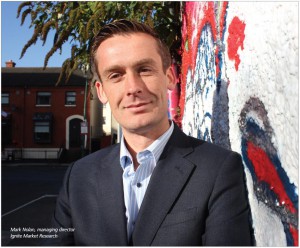 In a sector that constantly assesses and evaluates products and services, it should come as no surprise that its practitioners face similar scrutiny from clients, writes Paul Golden.
In a sector that constantly assesses and evaluates products and services, it should come as no surprise that its practitioners face similar scrutiny from clients, writes Paul Golden.
A checklist of the global trends impacting on the market research industry invariably includes things like the commoditisation of market research, the growth of do-it-yourself packages and web-based surveys, increased automation and industry consolidation.
However, there are a couple of disruptive macro trends that particularly resonate with local practitioners, such as the ‘transition to insights’. This is defined as marketing executives being no longer content to receive results from research providers that are little more than data-dumps and demanding that market research provides insights that lead to improved business decisions.
The most important step is to define the ‘problem’, says Oisin Byrne, managing director iReach. “In an ideal world, it is best to discover this with specific stakeholders through interviews and short and impactful workshops to understand how research insights will be used to answer the business questions and responses to recommendations.”
“Then the decision problem needs to be documented in the form of research questions to align with overall business objectives. Too often market researchers just take the questions from the client without fully understanding the overall client objective or the key business decision being made. Without this we see research not delivering value to the client and not helping direct decision making. Budget holders are becoming more aware of the need to deliver actionable insights and in turn measurable value for such research engagements.”
The market research industry spends too much time and energy showing its processes and workings, which often leads to the key learning and action points becoming obscured and diluted.
That is the view of Mark Nolan, managing director Ignite Market Research, which is part of Core Media.
“The pressure to cut through complexity and give insightful direction has always been there, but increasingly with clients under ever mounting pressure and being time poor there is a need for the research industry to drastically overhaul how we showcase and craft our outputs,” says Nolan.
Good market research now is the ability to use technology to deliver data fast and the ability to assimilate it, interpret it and make a good decision/recommendation, adds Richard Waring, partner Catalyst, the Dublin-based research firm that specialises in the retail sector.
“Increasingly, technology does most of the assimilating and interpreting, leaving the researcher at the recommendation stage. This is a key challenge as researchers’ ability to make recommendations of real value is not very highly valued by clients, except at the very senior level. This has commoditised the market research industry, so unless you have a unique, technology-based product or really outstanding consultants, you have little real differentiation as a company,” says Waring.
Others refer to a flurry of activity from firms that focus on the business intelligence space, as they apply their particular skills to challenges in big data that have captured the interest of so many in the market research industry.
According to Chris Larmour, TGI Ireland core product manager, alongside the broader movement towards big data there has been a fresh appetite in recent years to drive value from the stores of sometimes unrefined data that businesses are generating every day.
“This is an area where market research firms can really come into their own. As researchers, we are able to process and identify stories in a customer dataset and, as importantly, understand what is missing that would add meaning and value to a customer’s business. For example, mapping a research generated segmentation into a customer relationship management (CRM) system might provide extra insight on which types of user should be communicated with in a particular way.”
Such approaches are a win-win for researchers and their clients – they provide opportunities to capitalise on pre-existing data, but ensure that the expertise and skills of the researchers are used to decode the important messages that may lie hidden within their data.
“There are no doubt more opportunities in this space yet to be exploited,” adds Larmour. “Intelligent integration of data assets is something we are going to see more and more often in the coming years,” he adds.
A related development is the challenge of connecting the mountains of data now captured daily by all manner of devices appropriately and making sense of it all.
The extent to which the data supplied by market research firms gets fed into customer relationship management systems, sales forecasts or other business applications is totally dependent on how good the buyer is at optimising how they use the data and how good the supplier is at helping them integrate it within the company, acknowledges Waring.
“Most data doesn’t get directly plugged into a client’s internal business model, but rather is used alongside internal data to make a better/fuller decision. To feed external market research data directly into a client’s system it would need to be designed that way, which most research isn’t, because most clients are not prioritising that.
“But with the proliferation of data, client companies are increasingly having to integrate all these sources to make sense or use of them and there are increasing numbers of products and tools emerging to allow this. Then the client either does the interpretation itself or hires a consultant, which could be a company or an individual,” he says.
Data supplied by market research firms can be fed into a customer segmentation model, which can then be applied to complete customer databases. But Richard Colwell, CEO RED C Research & Marketing points out that respondent level information is never provided to end clients without the express permission of those interviewed.
He accepts that clients are conducting more in-house analysis of market research data than they did even 12 months ago, as the tools to support this activity have become more readily available. “However, most of the companies we work with know when it is important to get advice and help from the research agency to ensure this work is being conducted correctly. We have also found that while in-house tools help companies gather data, it is the skill of interpretation and the wider market knowledge that is sometimes missing,” says Waring.
Most organisations still look at market research on a project by project basis, adds Oisin Byrne. “While there is a lot of talk about big data or data analytics, we believe there is an untapped source of insight sitting within organisations, many of which are overloaded with data. We believe this will grow to become a focus area for organisations in Ireland in the next year or two.”
Investment in voice-of-customer implementations (especially in the financial services sector) is creating a platform for real time customer feedback, he continues.
“A knock-on benefit is the implementation of reporting dashboards, which can be extended to include other information sources such as customer relationship management and financial data to provide a more comprehensive view of overall business performance. This will continue to grow, as will integration of customer feedback with social media insights.”
Of course, established principles remain relevant. Justin Healy, managing director of research firm Spark points out that good market research is all about people, ideally curious people who understand that a well-executed research project has the power to hugely strengthen brand positions and is worth its weight in gold.
“A return on investment for the client, whatever the type of project, is what matters most.
During the recession years, proactive and strategically minded clients and marketing managers still conducted strategic projects (perhaps they didn’t have the budgets to check the smaller, tactical, issues). Some clients have seen the strategic element of their business move to the UK but as the recovery continues some of these roles have moved back to Ireland – Irish consumers are different to UK consumers, whatever some people may like to believe. Hopefully we will see this trend continue as the economy strengthens,” he says.
Luke Reaper, deputy managing director Behaviour and Attitudes, meanwhile, warns against being blinded by technology and says the most appropriate approach must still be employed.
“In terms of design, thought is critical and we feel sometimes this can be overlooked. We worry that the rationale for selecting certain research methodologies is not examined by some clients, especially procurement departments. It is important that clients know what they are buying. Despite the advancements, there is still no substitute for rigor in thinking – this is what delivers insight.”
He also refers to a trend for outsourcing of advanced data analyses. “Gone are the days of simple cross tabulations, with advanced driver analysis across multiple data sources now the norm. Many clients do not have the skill sets internally, or indeed the time for such detailed analysis. Thus the ‘data era’ for market research has very much arrived.”
When asked to describe the balance between tactical and strategic research in Ireland, Maureen Van Wijk, managing director Millward Brown Ireland says it depends on the type of company, their size and business strategy and objectives.
“Some companies, either Irish owned or with headquarters in Ireland are very strategically focused. Others headquartered abroad might be more tactical. Overall we still have very number of SME companies here who are doing both.”
Industry associations such as ESOMAR and AIMRO are there to guide and advise on good practice, she adds. “Of course, changes in regulations such as data protection law also help to maintain good practice from an overall business perspective. But most bigger and reputable agencies have also taken ownership to develop their own quality procedures, some using ISO.”
But while acknowledging that the majority of agencies are exercising their business with the utmost integrity and adherence to best practice, Mark Nolan also observes that there are no practical systems of regular monitoring of quality or oversight in place.
“This could be pointed to as a sizeable chink in the armour of how robust our industry checks and balances really are, across individual agencies and from project to project. Other industries have external audits and even league tables of professional standards in place – we do not.”
His concern is not about the technical rules on how to maintain quality of traditional techniques, but how best practice on these methods is becoming outdated and less relevant in extracting insightful and accurate information from contemporary consumers.
“Is it really acceptable that a human being in 2015 will do a 15 minute survey (or longer) and be engaged cognitively all the way through? In a world of 140 character attention span, the industry needs to revisit what are considered best practices in eliciting consumer feedback and input. Guidelines could be revised and updated to be more contemporary and relevant rather than what is increasingly being seen as a quasi-academic set of standards detached from the real world of commerce and marketing and consumer life.”
First published in Irish Marketing Journal (April 2015)© to order back issues please call 016611660





















